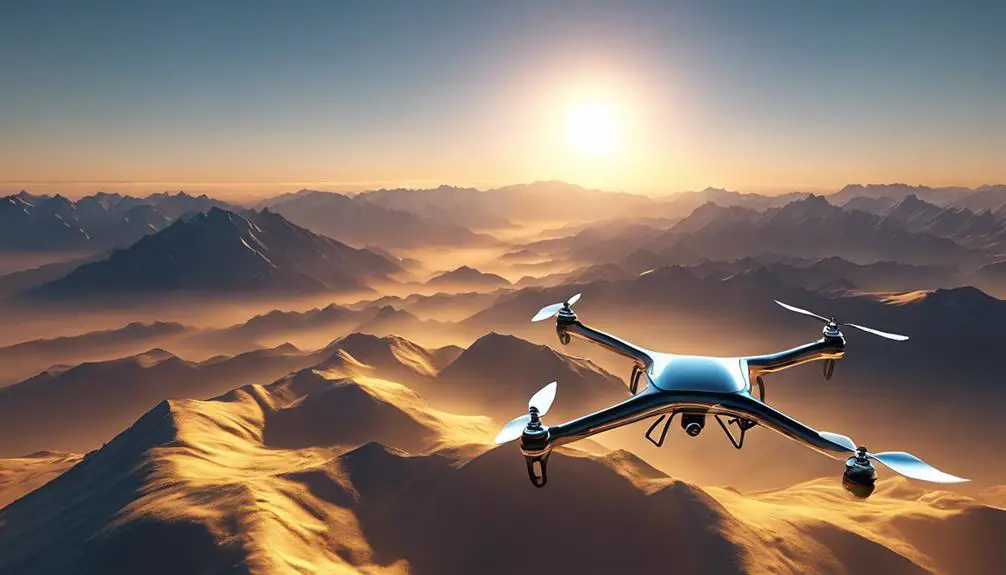You can usually fly a drone up to 400 feet above ground level, which is the maximum limit set by many regulations. Exceeding this height can not only put your drone at risk but may also lead to legal issues. Factors like drone weight, battery life, and weather conditions play a role in how high you can go. It's also essential to be aware of your local airspace rules as they can vary by location. Keeping these tips in mind will help you maximize your flying experience, and there's plenty more to discover about safe drone operations.
Understanding Drone Altitude Limits
Understanding the altitude limits of your drone is essential for safe and legal flying. You want the freedom to explore the skies, but pushing your drone too high can lead to trouble. Most consumer drones have a maximum altitude of around 400 feet above ground level, which helps you avoid collisions with manned aircraft. It's vital to be aware of these limits, as exceeding them could not only endanger your drone but also infringe upon others' airspace rights. Familiarize yourself with your drone's specifications and set altitude restrictions in the app, ensuring you stay within legal bounds. Embracing the thrill of flight means respecting the rules that keep everyone flying safely. Enjoy the freedom, but always fly smart!
Regulatory Guidelines by Country
When flying your drone, it's important to know that regulatory guidelines vary considerably from country to country. In the U.S., for instance, the FAA imposes a 400-foot altitude limit for recreational pilots, while in the UK, you can fly up to 400 feet but must keep your drone within visual line of sight. Countries like Canada require registration for drones over a certain weight and also enforce altitude limits. In contrast, some nations may have minimal regulations, allowing you more freedom but also posing risks. Always check local laws before you take off, as noncompliance can lead to fines or confiscation. Staying informed guarantees you can enjoy the skies while respecting the rules of each region.
Factors Affecting Drone Altitude
Several factors influence how high you can fly your drone, from its weight and battery life to environmental conditions like wind and temperature. Understanding these elements can help you maximize your flying experience and freedom in the skies.
| Factor | Impact on Altitude |
|---|---|
| Drone Weight | Heavier drones struggle to ascend |
| Battery Life | Low battery limits flight time |
| Wind Speed | High winds can hinder stability |
| Temperature | Cold temps can reduce battery efficiency |
Maximum Flight Altitudes
The maximum flight altitude for a drone can vary considerably based on regulations, drone specifications, and local airspace restrictions. Generally, in many countries, the legal limit is around 400 feet above ground level. However, you might find opportunities to soar higher in controlled environments or with special permissions. It's essential to stay informed about the rules in your area, as they can change and may differ markedly from one location to another. You want to enjoy the thrill of flying high, but safety and compliance should always be your priority. Remember, respecting airspace laws not only keeps you free to fly but also guarantees the skies remain safe for everyone. Keep exploring, but always check the regulations first!
Drone Specifications and Performance
Understanding how high you can fly a drone often depends on its specifications and performance capabilities. Each drone model has unique features, like motor power, battery life, and weight, which all affect altitude potential. For instance, a high-performance drone might reach impressive heights due to its robust build and advanced technology. You'll want to evaluate factors like maximum flight time and payload capacity, too—these can limit your ability to soar freely. Additionally, a drone equipped with GPS and stabilization systems can enhance flight stability at higher altitudes, ensuring smooth operation. Ultimately, knowing your drone's specs will empower you to explore the skies while maximizing your flying experience and achieving the heights you crave.
Airspace Classifications and Restrictions
Maneuvering airspace classifications and restrictions is essential for safely flying your drone. Understanding these regulations can help you explore the skies without limits.
Here's a breakdown of airspace classifications:
| Class | Description | Restrictions |
|---|---|---|
| Class A | High altitude, controlled | Must be IFR, ATC clearance required |
| Class B | Busy airports | ATC clearance required |
| Class C | Airports with control | ATC clearance required |
| Class D | Smaller airports | ATC communication required |
| Class G | Uncontrolled airspace | No restrictions, but stay alert |
Safety Considerations for High Flights
Flying your drone at high altitudes brings unique safety considerations that you need to be aware of, especially when maneuvering different airspace classifications. First, always keep an eye on surrounding air traffic. You don't want to mess with manned aircraft, so knowing the airspace structure is essential. Weather conditions can change quickly at higher elevations, so be prepared for sudden gusts or storms. Battery life also dwindles faster during high flights due to increased power consumption, so plan your flights accordingly. Finally, verify your drone's altitude settings are accurate to avoid unintended flyaways. Staying informed and vigilant will let you enjoy the freedom of high-altitude flying while keeping safety at the forefront.
Tips for Maximizing Flight Altitude
To maximize your drone's flight altitude, start by ensuring it's equipped with a high-quality battery that can handle the increased power demands of soaring higher. Next, consider these essential tips:
- Optimize Weight: Remove any unnecessary accessories to lighten your drone.
- Check Weather Conditions: Fly on calm days; wind can hinder altitude.
- Use a High-Quality Propeller: Upgrading to efficient propellers can increase lift and performance.
- Maintain Line of Sight: Keep visual contact with your drone to manage altitude safely.

